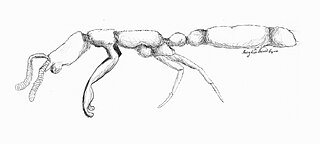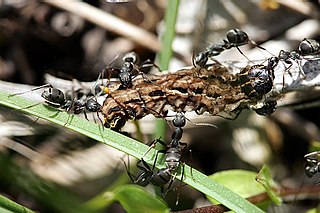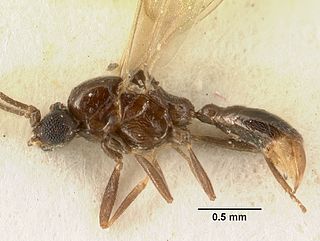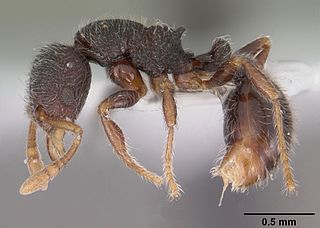
The name army ant (or legionary ant or marabunta) is applied to over 200 ant species in different lineages. Because of their aggressive predatory foraging groups, known as "raids", a huge number of ants forage simultaneously over a limited area.

Cardiocondyla is an Old World genus of ants in the subfamily Myrmicinae.

Acropyga is a genus of small formicine ants. Some species can be indirect pests. A. acutiventris, which is found from India to Australia, tends subterranean, root-feeding mealybugs of the species Xenococcus annandalei. Living, gravid females are carried in the jaws of A. acutiventris queens during their nuptial flight, to establish the symbiotic association in founding colonies. Other Acropyga species have relationships with different species of mealybugs, and it could be a trait common to the whole genus.

Leptanilla is a genus of ant in the subfamily Leptanillinae. Like other genera in this subfamily, the queen is fed by the hemolymph of their own larvae, which have specialized processes for this purpose.

Opamyrma hungvuong is a species of ant found in central Vietnam, first described in 2008. It is the only species in the genus Opamyrma. While originally classified in the subfamily Amblyoponinae, it is presently considered to belong to the subfamily Leptanillinae.

Aenictus is a large army ant genus distributed in the Old World tropics and subtropics. It contains about 181 species, making it one of the larger ant genera of the world.

Leptanilla japonica is an uncommon highly migratory, subterranean ant found in Japan. They are tiny insects, with workers measuring about 1.2 mm and queens reaching to about 1.8 mm, and live in very small colonies of only a few hundred individuals at a time Its sexual development follows a seasonal cycle that affects the colony's migration and feeding habits, and vice versa. L. japonica exhibits specialized predation, with prey consisting mainly of geophilomorph centipedes, a less reliable food source that also contributes to their high rate of nest migration. Like ants of genera Amblyopone and Proceratium, the genus Leptanilla engages in larval hemolymph feeding (LHF), with the queen using no other form of sustenance. LHF is an advantageous alternative to the more costly cannibalism. Unlike any other ant, however, members of Leptanilla, including L. japonica, have evolved a specialized organ dubbed the “larval hemolymph tap” that reduces the damage LHF inflicts on the larvae. LHF has become this species' main form of nutrition.

Formica japonica is a species of ant in the genus Formica. It is found in Russian, Mongolia, China, Korea, Japan, and Taiwan. It is one of the most common ants in Japan.

Stigmatomma is a genus of ants in the subfamily Amblyoponinae. The genus has a worldwide distribution, and like most other amblyoponines, Stigmatomma species are specialized predators. First described by Roger (1859), it was for a long time considered to be a synonym of Amblyopone until it was revived as an independent genus by Yoshimura & Fisher (2012) based on worker mandible morphology.

Probolomyrmex is a genus of ants in the subfamily Proceratiinae. The genus is distributed throughout the tropics and subtropics. The ants are very rare, and are rarely collected in the field, but they appear to be nesting in the leaf litter or in rotten wood. Little is known about their biology.

Yavnella is a genus of ants in the subfamily Leptanillinae. Its two species are distributed in India and Israel. The genus is known only from male specimens.

Anomalomyrma is an Asian genus of ants in the subfamily Leptanillinae. The genus was originally described in 1990 with the type species Anomalomyrma taylori, based on a single dealate queen from Borneo. Workers were unknown until 2011, when two new species were described from Peninsular Malaysia and the Philippines.

Phaulomyrma is a genus of ants in the subfamily Leptanillinae containing a single species, Phaulomyrma javana.

Protanilla is a genus of subterranean ants in the subfamily Leptanillinae. Known from the Indomalayan realm, the genus contains about thirteen species. The genus was erected by Taylor (1990) for the type species P. rafflesi, described from workers from Peninsular Malaysia. Species in this genus have long and downcurved mandibles with peg-like tooth on the inner margins. Four species are known from China, one from Taiwan, one from Sri Lanka and a couple from India.

Lasiomyrma is a South-East Asian genus of ants in the subfamily Myrmicinae. The genus is mainly known from tropical rainforests in Sundaland.
Formosimyrma is a genus of ants in the subfamily Myrmicinae containing the single species Formosimyrma lanuyensis.
Furcotanilla is a genus of ants in the subfamily Leptanillinae containing the single species Furcotanilla furcomandibula. The genus is close to Protanilla, from where the type species Protanilla furcomandibula was transferred from by Xu (2012). Its only species is known from Yunnan, China, where it nests in the soil and forages on the ground. Queens and males are unknown.

Myrmecia pyriformis, also known as the bull ant or inch ant, is an Australian ant. Myrmecia pyriformis belongs to the genus Myrmecia. It is abundant in many major cities of Australia, but mostly spotted in the eastern states. The species is of a similar appearance to the Myrmecia forficata.
















